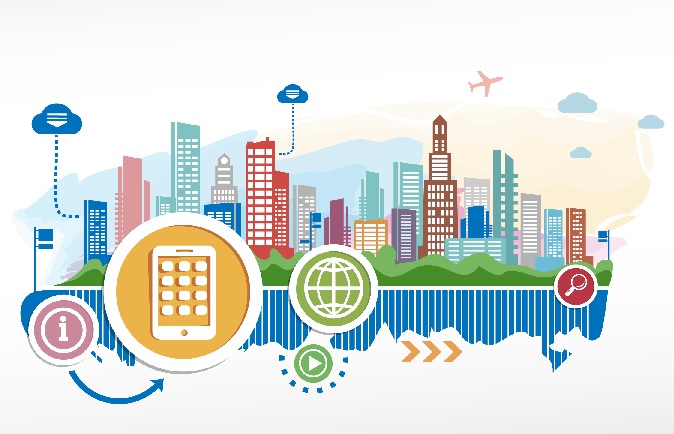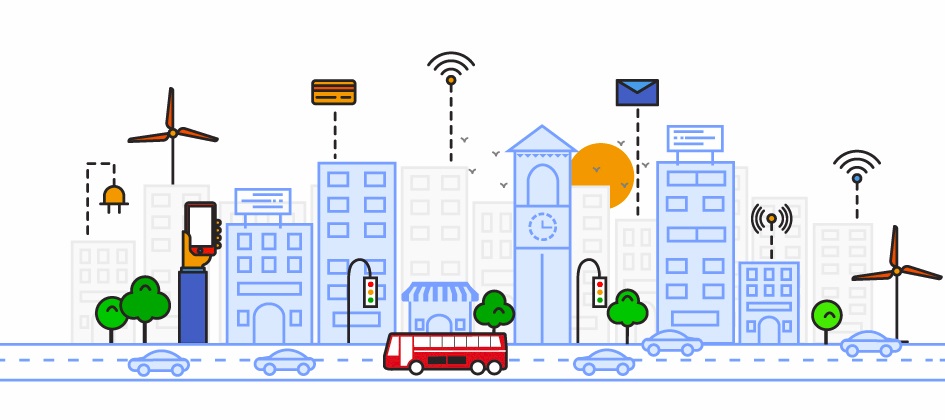Clean Electricity
The Grid as a Foundational Platform
Technologies such as such as wind, solar, “smart” appliances, and battery storage continue to evolve and popularize, creating what could be the most fundamental shift in the way that electricity has been delivered in over 100 years.
These new developments represent significant opportunities:
- Citizens have increasing choice over how they source and consume energy
- Clean power consumption is no longer a pipe dream; cities now have codified goals as a laudable step in the fight against climate change
- Citizens can become even more engaged as “prosumers” by sending energy back in to the grid
And significant challenges:
- Clean resources such as solar and wind generate varying amounts of power over short and long time durations, with varying power quality
- The grid will need more intelligence, communications, and automation to maintain reliability
- Regulations and market design will likely need to evolve
One could imagine an idealized Smart City end state: owners of just single Nest or Powerwall or entire microgrids or ecodistricts could automatically trade energy services on the grid as an integrated platform to take advantage of relative strengths and weaknesses of assets and behaviors across locations and times. Improved use of, and compensation for, customer energy activities could allow the electric system to become more democratic, efficient, responsive, and sustainable, creating a virtuous feedback loop in the process.
PG&E is taking a step towards smart platform enablement with the recent launch of a Distributed Energy Resources Management System (DERMS) pilot, in partnership with GE, Tesla, and Green Charge Networks. Within that pilot, customer solar smart inverters and storage batteries take signals from the grid management system to “bid” in needed services, and then remotely and automatically execute on those services to the grid once bids are accepted. This pilot will provide an early glimpse into the operation of a number of different pieces that need to work as an orchestrated whole to succeed. Ambitious pilot projects like DERMS could represent an exciting step towards a Smart Cities-enabling energy platform.
Data Access
Data itself is another enabler of informed energy choices. Data accessibility solutions need to be addressed thoughtfully, given a utility’s responsibility to safeguarding customer data privacy and grid security. PG&E has been particularly active in working through solutions in this area, creating multiple opt-in pathways for customers to securely access, download, and/or share their data with relevant 3rd parties. Utilities in different parts of the country have various degrees of readiness with regards to data access provision, but accessibility is undoubtedly a part of the solution.
Grid Expertise
Utilities have a great deal of in-house intelligence which can help smooth bumps in a Smart City transition, for example, towards increasing energy resilience.
- PG&E has been advising the City of Berkeley in their exploration of a resilient microgrid concept in the city core. The contemplated grid-tied microgrid in the area of the Center Street Garage would combine solar, battery storage, and existing diesel back-up generation to enhance community resilience
- PG&E also partnered on the planning and interconnection of the Blue Lake Rancheria Microgrid in Humboldt County, which enables their facilities to “island” in the event of a broader grid outage and remain a dependable community collection point during emergencies.
Acting as a knowledge repository to inform complicated grid edge deployments can help utilities disseminate best practices, and hopefully improve the chances of achieving desired outcomes.
Transportation
Electric Vehicle Charging Provision
Transportation is similarly subject to change, driven by electrification, car sharing, and automation. Electrification is clearly picking up steam:
- California has set an aggressive goal to get 1.5M zero emissions vehicles on state roads by 2025
- Volvo recently announced a phasing out of internal combustion-only cars by 2019
- The entire country of Norway is set to ban internal combustion car sales by 2025
The industry will need to adjust. But in order to achieve mass EV adoption, citizens need to feel confident that they will be able to get a charge when they need one.
Public charging has been slow to grow organically in California despite relatively high per capita penetration to date (1 in 5 US EVs are in PG&E territory). As a result, California investor owned utilities have been given approval for pilot projects that will install public charging infrastructure in their respective regions. PG&E roles, and proposed roles, include:
- Approval to currently roll out 5K “make ready” chargers and 2.5K “charging ready” deployments (including at low income and multi-unit dwelling locations, to help democratize access)
- Proposed a program to make 9K “make ready” chargers for fleets of non-light-duty vehicles, such as transit buses and package delivery trucks
- Proposed a program for 300 “make ready” fast chargers
If California is to meet its ambitious goals, such initial pilot activities will likely only be a small part of a broader solution. This evolution is in early stages and there is much work to be done.
Charging Planning Expertise
The EV charging infrastructure transition is a complex undertaking, and will require government-utility-industry collaboration to answer key questions. For example:
- Where should charging optimally take place?
- How powerful, and fast, do different charging stations need to be?
- When EV charging results in needed upgrades to local grid infrastructure, who pays?
The answers to these questions are still getting worked out in California. Active load management could be one solution to decreasing the grid impact of charging. To test one solution, PG&E and BMW joined up to pilot use of electric car batteries as a smart grid resource to smooth EV load. PG&E and UC Davis also developed initial analysis for optimal locations for such high-powered infrastructure. More innovation around efficient EV infrastructure build out is still needed.
City Intelligence
Physical Sensor Infrastructure
Smart Cities can be thought of as more than just networks of clean power or transportation. Communications, IT, and distributed sensor technology can unlock entire other categories of value, such as:
- Public WiFi provision
- Gunfire sensing
- Air quality monitoring
- Autonomous vehicle support
- Earthquake sensing
- Smart parking
But where should such distributed intelligence devices be located, where they will be secure, clear of significant obstructions, and ideally with a readily available power source?
Street lights are one option. Street lights are sometimes owned by electric utilities, but are more often owned by the city itself. A common complication however is that street lights can have static tariffs for only fixed energy use certain times of night. This prevents other devices from being legally connected, holding back broader Smart City potential. In response to customer demands two years ago PG&E’s Smart Meter team created a new type of street light sub-meter capable of splitting out energy use for multiple use cases. There are now hundreds of such units around the Bay Area, and commercial licenses have been issued for Smart City use elsewhere.

Utility poles are another path. Utility poles can often be shared by several utilities rather than one company alone. Devices legally mounted to pole tops must do so via an approved utility list, and electric utilities are a particularly good entrée if an electric tie-in is involved. PG&E has a department addressing this category of business, New Revenue Development (NRD), which has developed processes, authorizations, and contract templates to streamline the mounting of 3rd party vendor devices to distribution-level pole tops and as well as transmission towers (common practice for telecommunications customers).
One potential advantage to the utility pole top option vs. city-owned street lights is that a PG&E Master License Agreement can offer access to effectively half of California, as opposed to navigating one jurisdiction at a time.
Telecommunications
Voluminous data created within smart cities typically must be communicated in some way to provide value-added services. Some utilities, such as PG&E, have already invested enormously in mesh networks capable of wirelessly transmitting large volumes of data in the form of smart meter networks. There is spare capacity in such networks which could be shared, and theoretical value to allowing such sharing to happen. However, PG&E’s smart meter networks were not built to accommodate sharing in their initial deployment, thus potentially requiring additional investment in platform infrastructure to unlock additional Smart City value. PG&E’s NRD division also leases access to lit and dark fiber strung across PG&E assets which could be leveraged for Smart Cities purposes.
Visual intelligence
Vegetation-related issues are a leading cause of electricity outages; PG&E has thus built out LIDAR gathering capabilities to help manage vegetation risk and now collects data within PG&E’s rights of way (capable of going down to 2-3 cm of accuracy). Such data could also be leveraged by cities themselves for asset monitoring, solar irradiation analysis on any PV facilities, or any number of other use cases potentially via options like licensing or cost sharing.
In Summary
The above discussion is not a comprehensive list (not even having touched on future possibilities for gas, water, or hydrogen), but hopefully gives a better idea of the possibilities. Cities and Smart City vendors should be able to efficiently create value by leveraging infrastructure already in place rather than building anew. However, in many cases technology and regulatory challenges will need to be addressed to unlock the potential. The most important driver for overcoming such hurdles could likely start with identification of compelling business plans and value streams for impacted stakeholders, to provide impetus to break down barriers. It will be exciting to see what innovators come up with, and how cities can realize some of the promise of “getting smart” now and in years to come.
